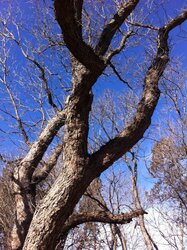I know this will be a lot easier to ID in a couple of months when everything starts to leaf out but I thought I would ask anyway. From what I can tell around the ground this tree has smooth and narrow pinnate leaves. The bark is scaly and flakes off easily. There are roughly 200 juvenile trees surrounding this one and they all have the same bark. I cut and split one of the smaller trees and the wood looks nearly identical to ash...but I don't think it's ash. I looked up native Oklahoma trees and found images of Kentucky Coffee Tree that look almost identical to this one.
Thoughts?
Thoughts?




 could focus on the twig pattern......the mnemonic here for opposite twig trees in the northeast is MAD dog - Maple, Ash, Dogwood
could focus on the twig pattern......the mnemonic here for opposite twig trees in the northeast is MAD dog - Maple, Ash, Dogwood .
.